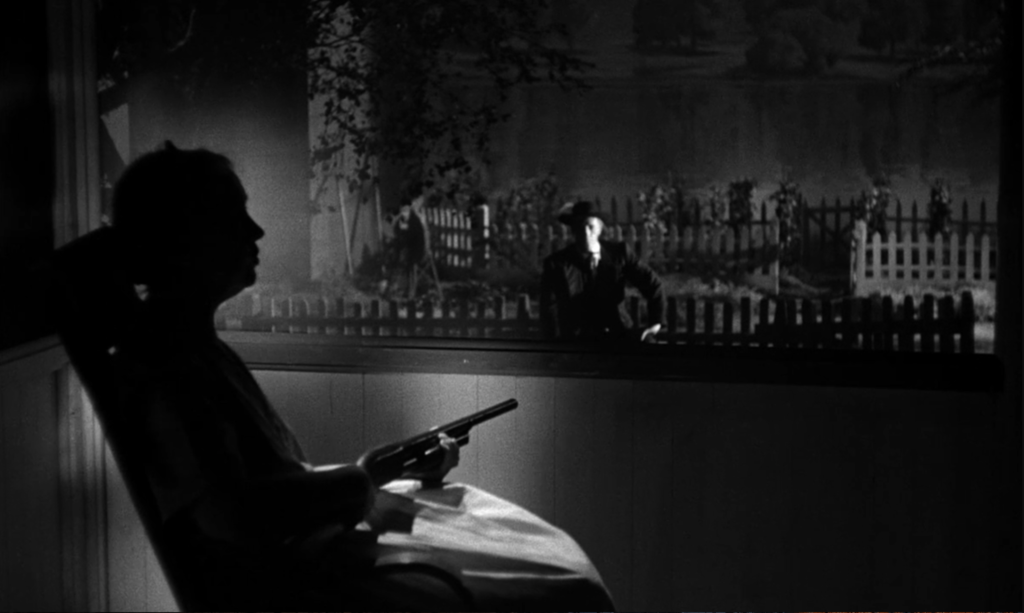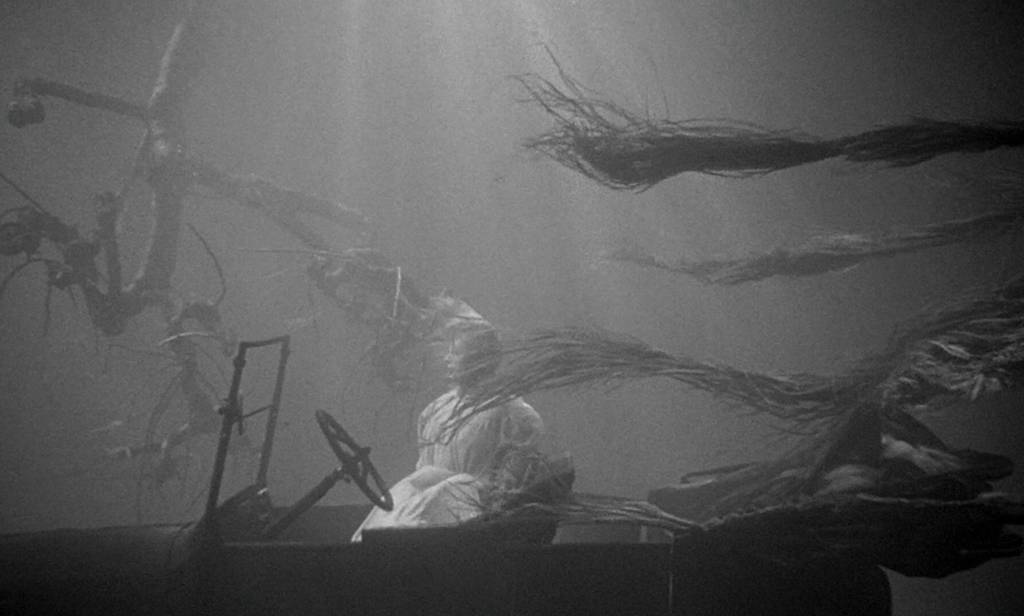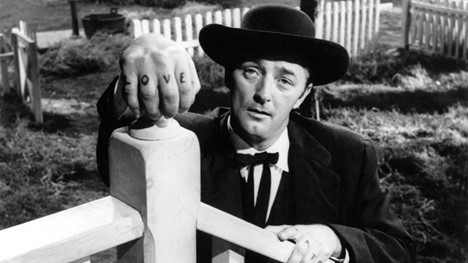
In Great Depression-era West Virginia, Ben Harper (Peter Graves) kills two men while robbing a store. Hiding the money in his daughter’s doll, Ben swears his two children to secrecy, intent that the stolen sum will be their inheritance. That vow ends up being the parting words for father and children, as Ben is hauled away to death row. Doubling the Harper family’s misfortune, Ben’s cellmate Harry Powell (Robert Mitchum), a killer disguised as a preacher, gets word of what his companion is in for. Once Powell’s sentence is up, he descends upon the Harper family, seducing the now-single mother Willa (Shelley Winters) so he can find the money for himself. To understand The Night of the Hunter (1955), this review will begin where the film ends. In the final scene, the thesis of the film is stated plainly with words and eyes directed toward the audience. No longer hunted by Powell, young John (Billy Chapin) and Pearl (Sally Jane Bruce) spend Christmas Eve with their new guardian, Rachel (Lillian Gish). The children’s caretaker gazes into the camera and offers the film’s final wisdom before the conclusion: “Lord save little children. The wind blows and the rain’s cold, yet they abide… they abide and they endure.”
Based on the identically named 1953 novel by Davis Grubb, The Night of the Hunter is unfortunately Charles Laughton’s only contribution to cinema made from the director’s chair. Much of academic film discourse is rooted in auteurism, which makes talking about The Night of the Hunter such a challenge. How can you talk about the directorial influence of this film when Laughton has no further filmography to compare The Night of The Hunter to? Not that this has made academics reluctant to engage; packaged in the film’s Criterion release is an audio commentary where the film’s second-unit director Terry Sanders is joined by academics from a range of disciplines: critic F. X. Feeney, archivist Robert Gitt, and Preston Neal Jones author of Heaven and Hell to Play with: The Filming of The Night of the Hunter.
At more than one point, the assembled commentariat compare Laughton to Orson Welles; The Night of the Hunter cinematographer Stanley Cortez had shot Welles’s The Magnificent Ambersons (1942). In another Criterion extra, mini-doc The Making of The Night of The Hunter, Feeney goes so far as to describe Laughton and Welles as “spiritual blood brothers.” There is more to link these two filmmakers than their shared work with Cortez. Both had negligent backgrounds behind the camera before debuting with masterpieces that broke contemporary convention to muted reception, only to later find their audience and then set convention. The Night of the Hunter is daringly ahead of its time cinematically – it displays a willingness to move the camera in a filmmaking era which appreciated the static shot and compositions that mixed “reality and expressionism” as said by Laughton biographer Simon Callow. It is not just craftsmanship where Laughton was thinking ahead. The film’s depiction of a serial killer and critique of Christianity may be old hat in the twenty-first century, but in 1955, it was daring enough that the film’s distribution was blocked in the cities of Memphis and Cheyenne.
It is a tragedy that, unlike Welles, Laughton’s career was limited to that debut. One way to compensate is to disregard an auteurist lens when looking at The Night of the Hunter and, if so, specific attention must be drawn to Cortez’s contributions. In a 1984 interview with the American Society of Cinematographers, Cortez describes his working relationship with Laughton and paints a picture of his director as a collaborative man, both with Cortez specifically and with the cast and crew: “Charles did not know too much about camera technique, he depended on me completely, and I’m not saying this with ego, that’s the truth… I learned more philosophically from Charles than he from me photographically… it was a marvelous marriage of two people with two potential talents.”

Cortez also declares, given how he was working with a novice director, that the lighting scheme of the film was his decision. He cites the shot of Powell’s enlarged shadow appearing in John and Pearl’s window as an example of where the film’s style is needed to communicate information concerning both story and mood to the audience. Cortez also states his preferred description for the film’s shadowed palette is “contrast” rather than “low-key”: “Low key is an erroneous expression… when people think in terms of low key they think in terms of using a very small amount of light.”
Yet, conversely, Laughton’s limited directorial career does make analysts’ jobs easier. To understand what fascinated Laughton as an artist, we need only look to one film instead of a career’s worth. These fascinations cast a shadow across the film like the striking, expressionistic shadows which populate so many of the film’s frames. Those shadows are one of the fascinations which merit investigation, for their presence indicates how Laughton made his personal mark on the story while staying faithful to how it was originally told by Grubb.
Grubb’s novel is a firmly American work. In a literal sense, it is set in the Ohio River Valley, West Virginia in particular. It also takes place during the 1930s, tracing how the Great Depression seeps into the lives of the characters. The book further uses Southern Gothic genre trappings, a genre rooted in American soil. One specific influence from American literature is how John and Pearl’s voyage down the Ohio River recalls the one Huck Finn and Jim took down the Mississippi in Mark Twain’s canonical novel. Laughton and screenwriter James Agee’s script is remarkably true to the original text, both in the aforementioned ways and in narrative. The film makes no significant deviations from the story as first written and almost all the dialogue is lifted directly from the source material. Yet, Cortez’s lighting designs import a European sensibility by harkening back to turn-of-the-century German Expressionist films, especially the heavy use of shadow. Near the end of the film’s second act, a shot of Powell chasing John and Pearl up a flight of basement stairs, arms outstretched like the boogeyman of many a child’s nightmare, makes the otherwise mundane villain look like Nosferatu from F. W. Murnau’s eponymous classic.
Powell himself, one of cinema’s greatest villains, deserves to be talked about in detail. Welcomed alternatively by a booming orchestral motif or a baritone belting out of “Leaning on the Everlasting Arms,” the Reverend is a wolf in the guise of a shepherd. Powell is so subsumed by Robert Mitchum’s performance that it is hard to envision anyone else in the role. Mitchum’s trademark cool aloofness helps tremendously to give the villain a sinister air. Powell may be detached and indifferent to the violence he doles out, but his restrained behavior makes it harder to predict when the rage and sadism boiling beneath his charm will bubble to the surface.
So great is Powell’s presence that one of the few differences from the source material is that the film opens with him rather than the children. Powell is introduced fleeing in a stolen car from his latest victim, the woman’s still feet the only sign of his black widower’s work. As Powell drives along, thanking the Lord for providing him a steady supply of victims, he notes, “Your book [the Bible] is full of killings.” Callow theorizes that Laughton, a closeted queer man, was in a prime position to understand and emphasize Christianity’s hypocrisy. The Church has a long history of exploitation and violence, which it cloaks behind sermons and hymns promoting goodwill, so Powell can be taken as an embodiment of that history which the Church would prefer to be kept from believers’ minds.
This opening further sets the tone for the film’s violence, remarkably obeying the Hays Code while not hiding the obvious that Powell is a serial killer. When he goes to strike Willa, the film wipe cuts to John and Pearl just as the switchblade penetrates Willa’s flesh. There can be no mistaking what has transpired, but the film declines to portray any sight of a blade piercing flesh. Viewers are provided only a clear view of the murder’s aftermath; there is a sickeningly beautiful scene of a dead Willa, underwater with a crashed car for company. Similarly, when Powell is trying to wring the location of the money from Pearl (“Tell me you little wretch, or I’ll tear your arm off!”), the film only shows the scene with audio. Powell and Pearl’s exchange plays over shots of Willa outside the family home, and by the time she has entered, Pearl is running away, screaming with fright. The film’s tendency to offer the mere suggestion of violence, even if brought about by creative limitations, makes the experience even more unnerving.
The next part of the film’s opening comes when Powell stops to visit a burlesque house. It is hard to think of a purer expression of disgust committed to film than the close-up of Powell’s face as the dancer before him gyrates onstage. In a wonderfully unsubtle visual gag, Powell’s hand retreats to his coat pocket then activates his switchblade. The preacher is clearly not as much of a puritan as he would like to be. Like all violent misogynists, especially those who convince themselves of their self-righteousness with religion, Powell’s loathing was born as lust. During this scene, the camera is sure to emphasize the knuckles of Powell’s left hand, tattooed with the word “hate,” mirroring his right hand, “love.” The tattoos are a clear statement on the duality of man, one Powell is shown to use in his preaching. The placement is no accident either; the left hand has long been viewed as a tool of the devil in Christianity, so it is only natural that a preacher, even a poser-of-a-preacher like Powell, would choose “hate” to be jotted across the knuckles of his southpaw. There is some irony in that this dichotomous symbolism comes from Powell, a character evil to his core with no redeeming qualities beyond his pretense of affability. Rather the counterpoint to Powell’s cruelty is not internal attributes or conflict within the villain himself, but instead an external, entirely separate character: Lillian Gish’s Rachel. Like Powell, Rachel is the children’s self-appointed guardian in the absence of their birth parents, but she is as compassionate as he is cruel, as loving of children as he is abhorrent of them.

This duality is also present in how the film centers the children and their viewpoint. At the same time, the film doesn’t obfuscate children’s capacity for cruelty either. After Ben is executed, John and Pearl are shown watching a group of children at the playground singing the “hangman” song, mocking the loss of their peers’ father. The film thus yet again plays into binaries of good and evil, and how all types of people have capacity for both. The difference between the cruelty of the people who torment John and Pearl is that Powell should know better, being both an adult and supposed man of God, whereas children are cruel because they do not comprehend how damaging their words or actions might be.
As The Night of the Hunter is so focused on the exploits of children, it must also be noted how the film captures the feel of the most enduring of children’s stories: the fairy tales of the Brothers Grimm. In his Criterion review “The Night of the Hunter: Holy Terror,” Terrence Rafferty describes children’s dreams as “part blind terror and part sweet hope.” Though The Night of the Hunter is filled with darkness and violence, there is a whimsy as well. The film also illustrates how that seeming binary between horror and innocence is in truth a false dichotomy. The world simultaneously seems simpler and scarier when one is a child, something which Laughton understood and captures onscreen through the experiences of John and Pearl.
The very first images of the film, preceding Powell’s introduction, are of Rachel from the shoulders up, double-exposed against the background of a starry night sky. Five children, lit against the same backdrop as Rachel, sit in a row and gaze up. The blocking calls to mind a teacher about to read a storybook to children. Rachel proceeds to warn the children and the audience alike: “Beware of false prophets who come to you in sheep’s clothing but inwardly they are ravening wolves” — the wolf in question is clearly Powell. The description could be read as a simple reference to the aphorism “a wolf in sheep’s clothing,” but it is important to note that some of the most famous Brothers Grimm tales, from “Red Riding Hood” to “The Three Little Pigs,” feature a wolf as the story’s villain. Like the wolves of those stories, Powell is a ravenous predator, albeit one who seeks to appease greed rather than gluttony, and sadistically torments those who are weaker than he.
Another fabled predator whom Powell shares his DNA with is Bluebeard. Like the titular murderer, Powell is a self-made widower many times over. Unfortunately for her children, Willa is not as clued in about her husband’s true nature as the last wife of Bluebeard was. This is the most reflexive case of folklore influence in the film, for at Powell’s trial after the full extent of his crimes and killings has been brought to light, members of a lynch mob derogatorily refer to him as a “Bluebeard.”
Returning focus to Rachel, Preston Jones notes in Criterion’s accompanying commentary for the film, as well as a featured documentary about its making, that Laughton saw Lillian Gish’s Rachel as a Mother Goose figure, lovingly helping wayward children. While Rachel leads all her adopted orphans away from the city main and the lynch mob in pursuit of Powell, they follow after her in single file, like ducklings following after their mother.
The storybook influences do not stop there. The opening hour of the film is most in line with “Hansel and Gretel.” Like in that tale, The Night of the Hunter features a brother and sister driven from their home by a newly arrived stepparent, condemned to hunger and wandering until they come across a new caretaker. Where the film diverges is that Rachel’s home turns out to be a refuge rather than a trap disguised as one. In either case, both stories end with the children free of their pursuer and welcomed into the arms of a loving parent. Whether faced with a cannibalistic witch or a serial-killing preacher, little children abide and endure.
Author Biography
Devin Meenan is a 2021 graduate of Denison University’s Cinema and Creative Writing programs. He is a prospective film critic, a full-time film lover, and a passionate writer.
References
Laughton, Charles, director. The Night of the Hunter. 1955, Written by James Agee, Performance by Robert Mitchum. United Artists. The Criterion Collection Blu-Ray.
Rafferty, Terrence. “The Night of the Hunter: Holy Terror.” The Criterion Collection, 16 Nov. 2010, https://www.criterion.com/current/posts/1657-the-night-of-the-hunter-holy-terror. Accessed 24 June 2021.
Sragow, Michael. “Downriver and Heavenward with James Agee.” The Criterion Collection, 18 Nov. 2010, https://www.criterion.com/current/posts/1658-downriver-and-heavenward-with-james-agee. Accessed 24 June 2021.
Film Details
The Night of the Hunter (1955)
USA
Director Charles Laughton
Runtime 93 minutes
Blu-ray
USA, 2014
Distributed by The Criterion Collection (region A/1)



































